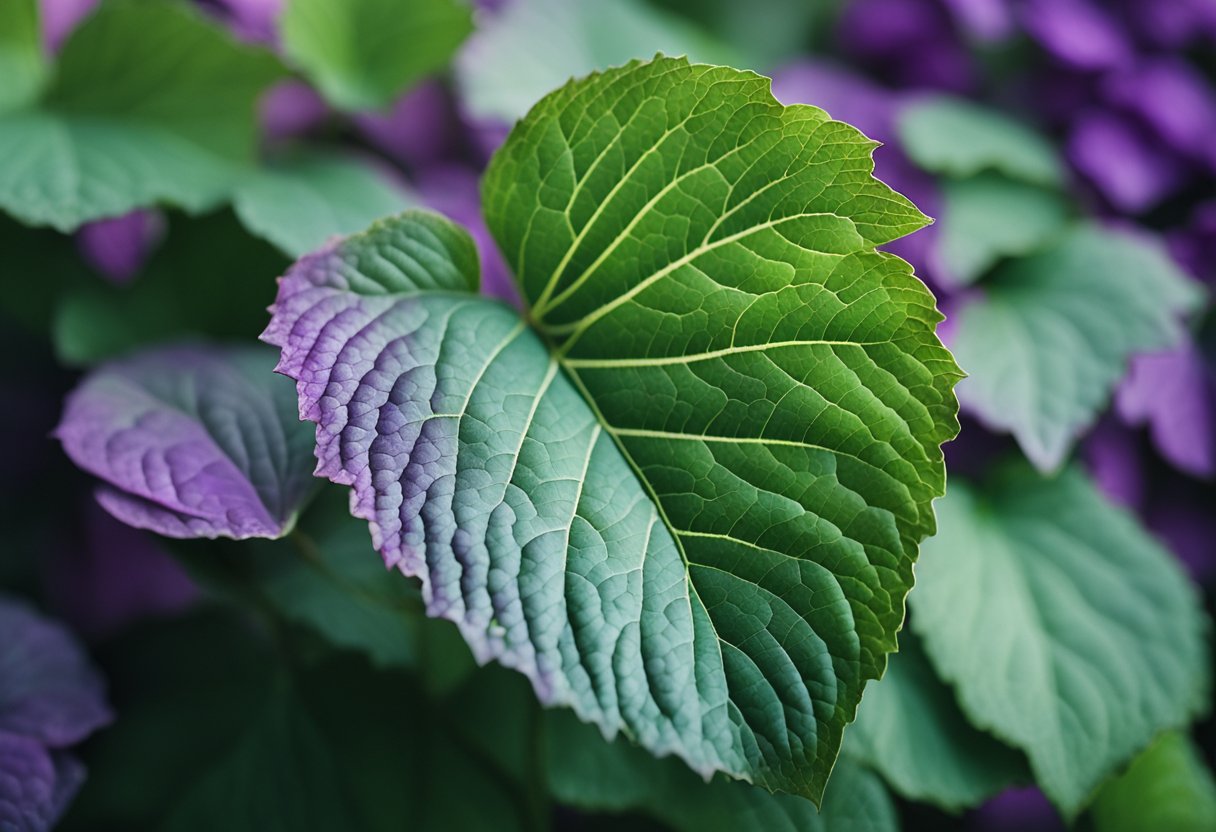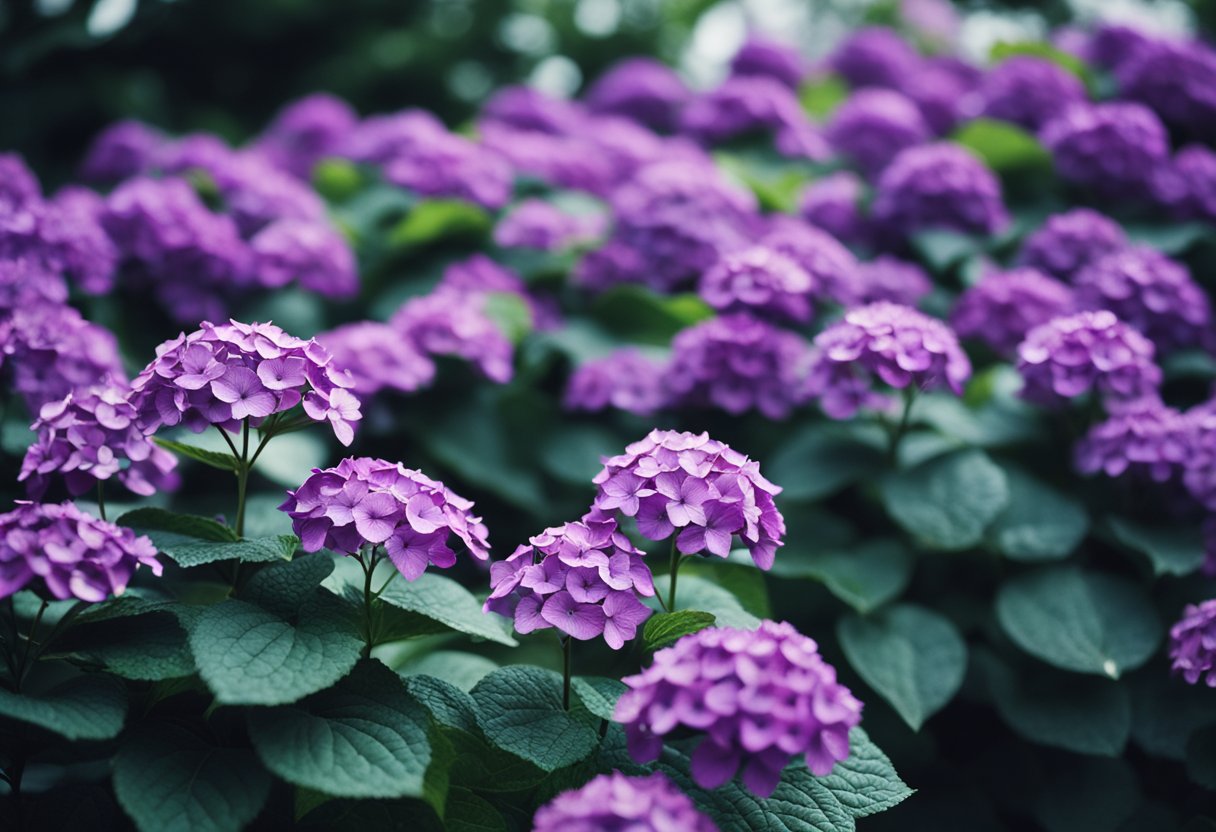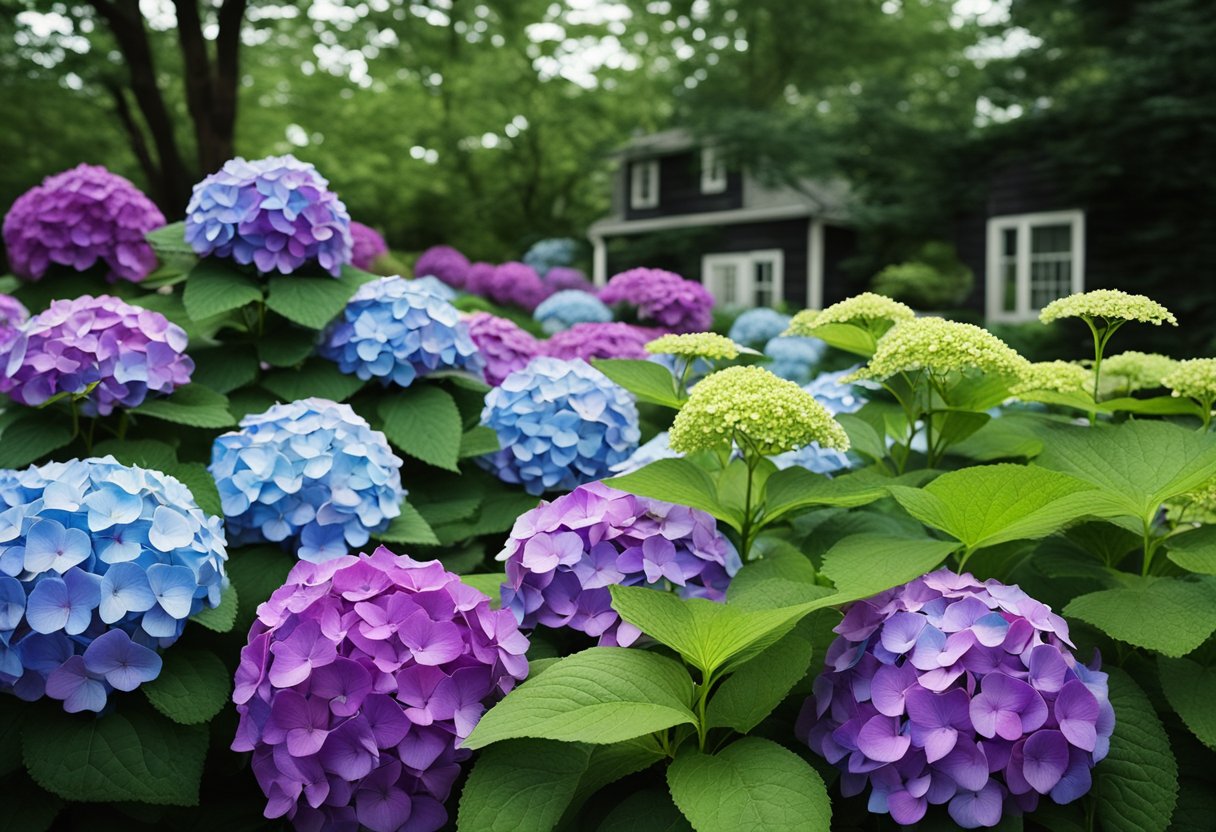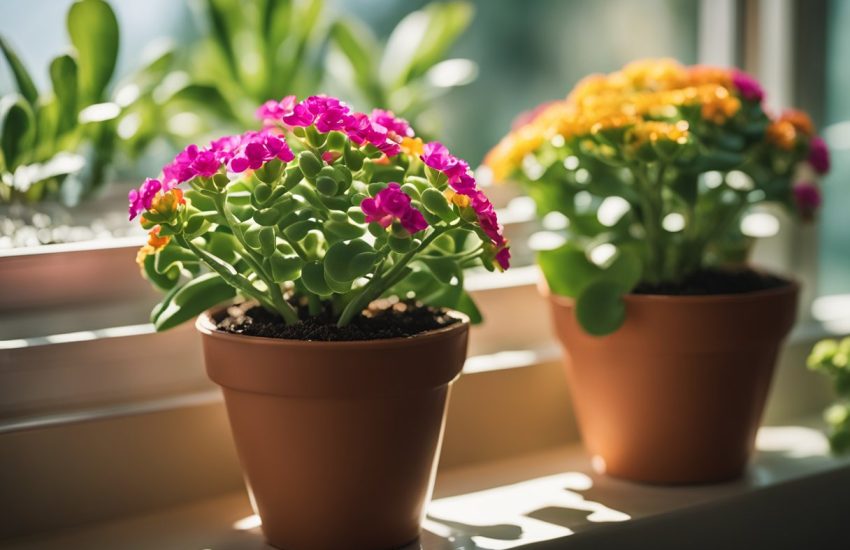Hydrangea Leaves Turning Purple: Causes and Solutions
Understanding Hydrangea Leaf Discoloration

Role of Chlorophyll in Leaf Pigmentation
Chlorophyll is the green pigment present in plants that helps them produce food through photosynthesis. The presence of chlorophyll gives leaves their characteristic green color. However, as the season changes, the levels of chlorophyll in leaves decrease, resulting in the exposure of other pigments that were previously masked by chlorophyll. This is why leaves tend to change color during the fall season.
Common Causes of Purple Leaves in Hydrangeas
Hydrangea leaves can turn purple due to a variety of reasons. One of the most common causes is a deficiency of phosphorus in the soil. Phosphorus is an essential nutrient for plant growth and development, and its deficiency can cause leaves to turn purple. Other possible causes include exposure to extreme temperatures, water stress, or fungal infections.
Another reason for purple leaves in hydrangeas could be due to genetics. Some hydrangea varieties naturally produce purple leaves, and this is not a cause for concern. However, if the leaves of your hydrangea plant suddenly turn purple and you suspect it is not due to genetics, it is advisable to check the soil pH levels and nutrient content to rule out any deficiencies.
In conclusion, understanding the role of chlorophyll in leaf pigmentation and common causes of purple leaves in hydrangeas can help gardeners identify and address any issues their plants may be facing. By maintaining optimal soil conditions and providing adequate nutrients, gardeners can ensure that their hydrangea plants remain healthy and vibrant.
Soil Conditions and Nutrient Levels
Soil pH and Its Effect on Hydrangea Leaves
The pH level of soil is a crucial factor in determining the color of hydrangea leaves. Hydrangeas grown in acidic soil with a pH level of 5.5 or lower tend to produce blue flowers and leaves, while those grown in alkaline soil with a pH level of 6.5 or higher produce pink flowers and leaves. When the pH level of the soil is in between 5.5 and 6.5, the flowers and leaves of hydrangeas can be purple or a mix of pink and blue.
Identifying Nutrient Deficiencies
Hydrangea leaves can turn purple due to nutrient deficiencies, particularly phosphorus and magnesium. A lack of phosphorus can cause the leaves to turn purple, while magnesium deficiency can cause the veins of the leaves to turn purple.
Amending Soil for Optimal Hydrangea Health
To prevent nutrient deficiencies and ensure optimal hydrangea health, it is essential to amend the soil with the necessary nutrients. Soil testing can help determine the nutrient levels in the soil and identify any deficiencies. Adding amendments such as sulfur, phosphorus fertilizer, and magnesium can help adjust the pH level and provide the necessary nutrients for healthy growth. Calcium and iron are also essential nutrients for hydrangea growth, and adding them to the soil can help prevent nutrient deficiencies. It is recommended to amend the soil before planting hydrangeas to ensure optimal growth and prevent nutrient deficiencies.
Watering Practices and Hydrangea Care
Proper Watering Techniques for Hydrangeas
Hydrangeas require adequate water to thrive, but overwatering can lead to root rot and fungal diseases. It is important to water hydrangeas deeply and regularly, especially during hot and dry weather. A good rule of thumb is to water hydrangeas once or twice a week, depending on rainfall and soil moisture.
To ensure that the water reaches the roots, it is best to water hydrangeas at the base of the plant rather than from above. This can be done using a soaker hose or drip irrigation system. Mulching around the base of the plant can also help retain moisture in the soil.
Effects of Overwatering and Underwatering
Overwatering can lead to waterlogged soil, which can suffocate the roots and cause root rot. This can result in yellowing leaves, stunted growth, and wilting. On the other hand, underwatering can lead to drought stress, which can cause the leaves to turn brown and crispy.
To avoid these issues, it is important to monitor the soil moisture level and adjust watering accordingly. Hydrangeas prefer moist, well-drained soil but can tolerate some dryness between waterings.
Optimizing Irrigation for Disease Prevention
Proper irrigation practices can also help prevent fungal diseases such as powdery mildew and leaf spot. These diseases thrive in humid and moist conditions, so it is important to avoid overhead watering and to water early in the day to allow the leaves to dry before nightfall.
In addition, good air circulation around the plant can help prevent fungal diseases. This can be achieved by pruning the plant to remove any crowded or crossing branches and by spacing plants at least 3 feet apart.
Overall, proper watering and irrigation practices are essential for the health and vitality of hydrangeas. By following these guidelines, gardeners can enjoy beautiful and healthy hydrangeas for years to come.
Weather-Related Stress and Damage

Hydrangeas are sensitive plants that can be easily affected by weather changes. Weather-related stress can cause leaves to turn purple, among other issues. In this section, we will discuss the impact of frost and cold weather, as well as dealing with heat stress and sunburn.
Impact of Frost and Cold Weather on Hydrangeas
Hydrangeas are vulnerable to frost damage, especially during the winter months. When temperatures drop below freezing, the water in the plant’s cells freezes and expands, causing the cells to burst. This can result in damage to the leaves, stems, and buds.
To minimize the impact of cold weather on hydrangeas, it is important to take preventative measures. Covering the plants with a blanket or tarp can help protect them from frost damage. Additionally, planting hydrangeas in a sheltered area can help shield them from the cold.
Dealing with Heat Stress and Sunburn
Hydrangeas can also be affected by too much sun and extreme temperatures. When exposed to direct sunlight for extended periods, the leaves can become scorched and turn purple. This is known as sunburn.
To prevent sunburn, it is important to plant hydrangeas in partial sun or shade. Additionally, watering the plants regularly can help keep them hydrated and cool during hot weather.
In conclusion, weather-related stress can cause hydrangea leaves to turn purple. Frost damage and cold weather can harm the plant’s cells, while too much sun and sunburn can cause the leaves to become scorched. By taking preventative measures and providing proper care, gardeners can help keep their hydrangeas healthy and vibrant.
Fungal Diseases and Hydrangea Leaf Health

Hydrangeas are a popular flowering plant that can add color and beauty to any garden. However, they are susceptible to a variety of fungal diseases that can cause their leaves to turn purple. This section will focus on two common fungal diseases that affect hydrangeas and provide tips on how to identify and treat them.
Identifying and Treating Cercospora Leaf Spot
Cercospora leaf spot is a fungal disease that causes purple spots to appear on the leaves of hydrangeas. These spots can vary in size and shape and may have a yellow halo around them. Over time, the spots can merge together, causing the leaves to turn completely purple and eventually brown.
To treat cercospora leaf spot, it is important to remove any infected leaves and dispose of them properly. Fungicide sprays can also be used to prevent the spread of the disease. Some common fungicides that can be used to treat cercospora leaf spot include azoxystrobin, chlorothalonil, mancozeb, myclobutanil, and thiophanate-methyl. It is important to follow the instructions on the label carefully when using fungicide sprays.
Preventative Measures and Fungicide Options
Preventing fungal diseases is always better than treating them. To prevent cercospora leaf spot and other fungal diseases, it is important to keep the area around the plant clean and free of debris. Watering the plant at the base and avoiding getting the leaves wet can also help prevent fungal spores from spreading.
If you do need to use fungicide sprays, it is important to choose the right product for the job. Some fungicides are broad-spectrum, meaning they can kill a wide variety of fungi, while others are specific to certain types of fungi. It is also important to follow the instructions on the label carefully and apply the fungicide at the right time to ensure it is effective.
In conclusion, fungal diseases can cause hydrangea leaves to turn purple, but with proper identification and treatment, they can be controlled. By taking preventative measures and using fungicide sprays when necessary, you can keep your hydrangeas healthy and beautiful.
Seasonal Changes and Dormancy

Understanding Fall Transition and Leaf Color Changes
Hydrangea leaves turning purple is a natural occurrence during the fall season. As the days shorten and temperatures cool, the plant’s metabolism slows down, causing a decrease in chlorophyll production. Chlorophyll is responsible for the green color of leaves, so as it breaks down, other pigments become visible, giving the leaves a purple hue.
This seasonal change is a normal part of the plant’s life cycle, and it does not necessarily indicate any problems with the plant’s health. In fact, some hydrangea cultivars are specifically bred to produce purple leaves in the fall, adding to their ornamental value.
Hydrangea Dormancy and Winter Preparation
As winter approaches, hydrangeas enter a period of dormancy, where they slow down their growth and conserve energy. During this time, it is important to prepare the plant for the harsh winter conditions.
One way to do this is to provide a layer of mulch around the base of the plant. This will help insulate the roots and protect them from freezing temperatures. It also helps to retain moisture in the soil, which is important for the plant’s survival during the winter.
It is also important to avoid pruning the plant during this time, as it can stimulate new growth that is vulnerable to frost damage. Instead, wait until early spring to prune any dead or damaged branches.
By understanding the natural fall transition and dormancy of hydrangeas, gardeners can better care for their plants and ensure their survival through the winter months.
Gardening Practices for Healthy Hydrangeas

Hydrangeas are beautiful and popular plants that can add a lot of charm and color to any garden. However, they can also be quite finicky and require some specific care to thrive. In this section, we will discuss some of the best gardening practices for ensuring that your hydrangeas stay healthy and vibrant.
The Importance of Air Circulation and Sunlight
One of the most important factors in keeping your hydrangeas healthy is ensuring that they have good air circulation and receive adequate sunlight. Poor air circulation can lead to the growth of fungi and other harmful organisms that can damage the plant. Additionally, hydrangeas require at least 6 hours of sunlight per day to thrive. If your hydrangeas are not getting enough sunlight, you may notice that their leaves are turning purple or that they are not blooming as much as they should.
To promote good air circulation, it is important to space your hydrangeas out properly and avoid planting them too close together. Additionally, you should avoid planting them in areas where there is a lot of shade or where the air is stagnant. If you notice that your hydrangeas are not getting enough sunlight, you may need to trim back nearby trees or bushes to allow more light to reach them.
Pruning Techniques and Timing for Hydrangeas
Pruning is an important part of keeping your hydrangeas healthy and vibrant. However, it is important to use the right techniques and timing when pruning your plants. Improper pruning can damage the plant and lead to stunted growth, poor blooming, and other problems.
The best time to prune hydrangeas depends on the type of plant you have. For example, if you have a bigleaf hydrangea, you should prune it after it blooms in the summer. If you have a smooth hydrangea, you should prune it in late winter or early spring before it starts to grow new leaves. When pruning your hydrangeas, it is important to use sharp, clean tools and to make clean cuts at a 45-degree angle.
Using Mulch and Fertilizers Effectively
Mulch and fertilizer can be very helpful in promoting the health and growth of your hydrangeas. Mulch can help to retain moisture in the soil and regulate the temperature around the plant, while fertilizer can provide essential nutrients that the plant needs to thrive.
When using mulch, it is important to avoid piling it too high around the base of the plant, as this can lead to rot and other problems. Instead, spread a thin layer of mulch around the plant, leaving a small gap between the mulch and the base of the plant.
When fertilizing your hydrangeas, it is important to use a balanced fertilizer that contains equal amounts of nitrogen, phosphorus, and potassium. You should also avoid over-fertilizing, as this can lead to excessive growth and poor blooming. A good rule of thumb is to fertilize your hydrangeas once in the spring and once in the fall.
By following these gardening practices, you can help to ensure that your hydrangeas stay healthy and vibrant for years to come.
Frequently Asked Questions

What causes the color change to purple in hydrangea leaves?
The color change to purple in hydrangea leaves is due to a phosphorus deficiency in the soil. When the soil lacks phosphorus, the plant cannot produce enough chlorophyll, which is responsible for the green color in leaves. As a result, the leaves turn purple.
How can I treat phosphorus deficiency in hydrangeas?
To treat phosphorus deficiency in hydrangeas, you can add a phosphorus-rich fertilizer to the soil. Bone meal, rock phosphate, and superphosphate are all good sources of phosphorus. You can also add compost or manure to the soil to increase the phosphorus content.
What are the signs of an unhealthy hydrangea plant?
An unhealthy hydrangea plant may have yellowing or curling leaves, stunted growth, or wilting. The plant may also have brown spots on the leaves or stems, or it may have a moldy or musty smell. If you notice any of these signs, it is important to take action to improve the health of the plant.
Can leaf spot fungus cause hydrangea leaves to change color?
Yes, leaf spot fungus can cause hydrangea leaves to change color. Leaf spot fungus is a common disease that affects hydrangeas, and it can cause brown or purple spots on the leaves. If left untreated, the disease can cause the leaves to turn yellow and fall off.
What does mold on hydrangea leaves indicate?
Mold on hydrangea leaves can indicate a fungal disease, such as powdery mildew or downy mildew. These diseases can cause white or grayish mold to form on the leaves, and they can also cause the leaves to turn yellow or brown. It is important to treat fungal diseases promptly to prevent them from spreading.
How does one manage purple stems in hydrangeas?
To manage purple stems in hydrangeas, you can add a phosphorus-rich fertilizer to the soil. You can also prune the plant to remove any dead or diseased stems. It is important to maintain good soil health and to water the plant regularly to prevent stress.


